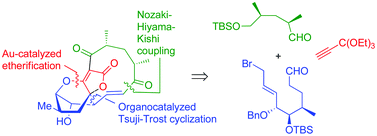Total synthesis and biological evaluation of (−)-atrop–abyssomicin C†
Abstract
Enantioselective synthesis of a marine

* Corresponding authors
a
Faculty of Chemistry, University of Belgrade, Studentski trg 16, POB 51, 11158 Belgrade 118, Serbia
E-mail:
rsaicic@chem.bg.ac.rs
Fax: +38111 3282537
Tel: +38111 3282537
b School of Medicine, Department of Chemistry, University of Belgrade, Visegradska 26, Belgrade, Serbia
c ICTM Center for Chemistry, Njegoseva 12, Belgrade, Serbia
Enantioselective synthesis of a marine

 Please wait while we load your content...
Something went wrong. Try again?
Please wait while we load your content...
Something went wrong. Try again?
F. Bihelovic, I. Karadzic, R. Matovic and R. N. Saicic, Org. Biomol. Chem., 2013, 11, 5413 DOI: 10.1039/C3OB40692J
To request permission to reproduce material from this article, please go to the Copyright Clearance Center request page.
If you are an author contributing to an RSC publication, you do not need to request permission provided correct acknowledgement is given.
If you are the author of this article, you do not need to request permission to reproduce figures and diagrams provided correct acknowledgement is given. If you want to reproduce the whole article in a third-party publication (excluding your thesis/dissertation for which permission is not required) please go to the Copyright Clearance Center request page.
Read more about how to correctly acknowledge RSC content.
 Fetching data from CrossRef.
Fetching data from CrossRef.
This may take some time to load.
Loading related content
